| کد مقاله | کد نشریه | سال انتشار | مقاله انگلیسی | نسخه تمام متن |
|---|---|---|---|---|
| 4743393 | 1641798 | 2015 | 11 صفحه PDF | دانلود رایگان |
• A total of 3810 landslides triggered by the Lushan earthquake were identified.
• The size of the landslides triggered by the Lushan earthquake is in general much smaller.
• The most common types of landslides were rock falls and shallow landslides.
• We found that the distribution pattern of landslides was not associated with the “hanging wall” effect.
The 20 April 2013 Lushan earthquake with a magnitude of Ms 7.0 induced widespread landsliding along the southern segment of the Longmen Shan fault zone. This paper presents a preliminary analysis of the characteristics of these co-seismic landslides triggered in an area of 13,323 km2. A total of 3810 individual landslide points were identified through an intensive field investigation and from digital aerial photographs taken after the Lushan earthquake. To facilitate the more detailed analysis on the areal frequency of co-seismic landslides as polygons, we selected an area of 732 km2 around the epicenter that had the highest density of co-seismic landslides. The sizes of the landslides are, in general, much smaller than those that were triggered by the 2008 Wenchuan earthquake. The most common types of landslides in the study area were rock falls and shallow, disrupted landslides from steep slopes, which typically involved the top few meters of weathered bedrock and colluvium. In this study, the relation between the landslide distribution and five main factors was analyzed: fault proximity, epicenter proximity, peak ground acceleration (PGA), slope angle, and lithology. Our study results show that the landslide concentration tends to decrease with distance from the seismogenic fault, and the highest landslide concentration is located within a distance of 5 km. Regarding the distance to the epicenter, the largest landslide density is found at a distance between 5 and 10 km. The landslide concentration also increases with increasing slope angle until a maximum for the slope class 45°–55°. In addition, results show that slopes consisting of deeply weathered and fractured sandstones and mudstones were the most susceptible to co-seismic landslides. In this study, we found that the location of the hanging wall and the footwall of the fault did not seem to have an important effect on the landslide distribution. This is in contradiction to what has been reported in other earthquake areas such as the Wenchuan area.
Journal: Engineering Geology - Volume 187, 17 March 2015, Pages 45–55
